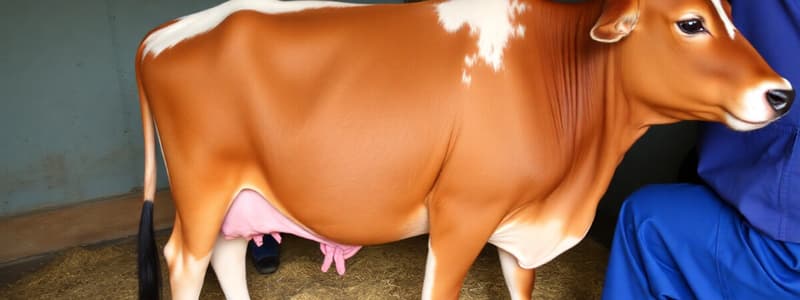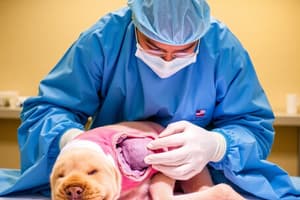Podcast
Questions and Answers
Which factor is least likely to contribute directly to abomasal displacement in cattle?
Which factor is least likely to contribute directly to abomasal displacement in cattle?
- Consistent feeding practices and balanced total mixed rations (TMR) with adequate fiber length. (correct)
- Metabolic stress due to diseases such as metritis or mastitis in the early post-partum period.
- Genetic predisposition, especially in dairy breeds like Holsteins.
- High-starch, low-roughage diets leading to increased gas production.
What is the primary rationale for recommending an oral drench of KCl after correcting abomasal displacement in cattle?
What is the primary rationale for recommending an oral drench of KCl after correcting abomasal displacement in cattle?
- To prevent metabolic acidosis by increasing the excretion of bicarbonate.
- To counteract hypophosphatemia and hypocalcemia commonly associated with displaced abomasum.
- To address hypokalemia resulting from sequestration in the abomasum, reduced feed intake, and metabolic alkalosis. (correct)
- To enhance abomasal motility and prevent recurrence of displacement.
Which of the following best describes the significance of measuring beta-hydroxybutyrate (BHB) in cows undergoing surgery for left displaced abomasum (LDA)?
Which of the following best describes the significance of measuring beta-hydroxybutyrate (BHB) in cows undergoing surgery for left displaced abomasum (LDA)?
- High BHB levels are indicative of successful surgical outcomes and reduced risk of post-operative complications.
- Low BHB levels are associated with increased likelihood of survival and remaining in the herd 30 days post-surgery.
- Lower BHB levels may indicate a poorer prognosis; cows with lower BHB are less likely to remain in the herd 30 days after surgery. (correct)
- BHB levels do not correlate with surgical outcomes for LDA and are primarily indicative of concurrent liver disease.
In the context of abomasal displacement, what is the most likely implication of a total mixed ration (TMR) with a carbohydrate:roughage mismatch?
In the context of abomasal displacement, what is the most likely implication of a total mixed ration (TMR) with a carbohydrate:roughage mismatch?
Why is erythromycin considered a potent motility enhancer for the abomasum in cattle, while other prokinetics show limited efficacy?
Why is erythromycin considered a potent motility enhancer for the abomasum in cattle, while other prokinetics show limited efficacy?
Which of the following factors would most likely contraindicate a ventral approach for surgical correction of abomasal displacement?
Which of the following factors would most likely contraindicate a ventral approach for surgical correction of abomasal displacement?
What is the primary reason for avoiding the pylorus itself when performing an abomasopexy during a right flank approach to correct an LDA?
What is the primary reason for avoiding the pylorus itself when performing an abomasopexy during a right flank approach to correct an LDA?
How does increased grazing time and higher roughage intake in cattle diets reduce the risk of abomasal displacement?
How does increased grazing time and higher roughage intake in cattle diets reduce the risk of abomasal displacement?
In cases of abomasal volvulus, what is the most critical consequence of direct vascular damage to the abomasal wall?
In cases of abomasal volvulus, what is the most critical consequence of direct vascular damage to the abomasal wall?
Which diagnostic finding would lead a clinician to suspect Duodenal Sigmoid Flexure Volvulus (DSFV) post-operatively following a right flank omentopexy for abomasal displacement?
Which diagnostic finding would lead a clinician to suspect Duodenal Sigmoid Flexure Volvulus (DSFV) post-operatively following a right flank omentopexy for abomasal displacement?
What is a key difference between the left flank and right flank approaches for surgical correction of LDA, concerning abdominal exploration?
What is a key difference between the left flank and right flank approaches for surgical correction of LDA, concerning abdominal exploration?
Besides Clostridium perfringens Type A what other factors contribute to the development of abomasitis in calves?
Besides Clostridium perfringens Type A what other factors contribute to the development of abomasitis in calves?
What is the underlying cause of abomasal impaction related to 'lousy cattle'?
What is the underlying cause of abomasal impaction related to 'lousy cattle'?
Which of the following best explains why Channel Island breeds may be more susceptible to abomasal displacement?
Which of the following best explains why Channel Island breeds may be more susceptible to abomasal displacement?
What is the primary rationale for early surgical intervention in cases of abomasal displacement?
What is the primary rationale for early surgical intervention in cases of abomasal displacement?
In diagnosing a left sided ping in beef cattle, what differential diagnosis should be considered?
In diagnosing a left sided ping in beef cattle, what differential diagnosis should be considered?
What is the significance of fiber quality in the context of preventing abomasal displacement, and how does it relate to rumen fill?
What is the significance of fiber quality in the context of preventing abomasal displacement, and how does it relate to rumen fill?
How do observational pre-existing risks, such as respiratory diseases like necrotic laryngitis, potentially predispose cattle to abomasal displacement?
How do observational pre-existing risks, such as respiratory diseases like necrotic laryngitis, potentially predispose cattle to abomasal displacement?
Which factor most accurately describes the significance of electrolyte derangements in the context of abomasal displacement and its correction?
Which factor most accurately describes the significance of electrolyte derangements in the context of abomasal displacement and its correction?
What is the primary advantage of using a toggle instrument or large needle in the ventral approach for abomasopexy?
What is the primary advantage of using a toggle instrument or large needle in the ventral approach for abomasopexy?
Flashcards
Abomasal Displacement
Abomasal Displacement
Physical displacement of the abomasum, can be a metabolic disease triggered by other metabolic issues post-partum or during lactation.
High carbohydrate, low roughage diets
High carbohydrate, low roughage diets
Increased risk of displaced abomasum occurs with this type of diet. Can result in decreased rumen fill and increased abomasal fermentation.
Electrolyte Derangements
Electrolyte Derangements
Electrolyte imbalances, particularly of calcium, phosphorus, magnesium, and potassium, increase the risk of displaced abomasum.
Metabolic Profile of DA
Metabolic Profile of DA
Signup and view all the flashcards
Surgical Approaches to DA Repair
Surgical Approaches to DA Repair
Signup and view all the flashcards
Abomasitis in Calves
Abomasitis in Calves
Signup and view all the flashcards
Risk Factors for Abomasitis in Calves
Risk Factors for Abomasitis in Calves
Signup and view all the flashcards
Abomasal Impaction
Abomasal Impaction
Signup and view all the flashcards
Breed Predisposition to DA
Breed Predisposition to DA
Signup and view all the flashcards
BHB as a DA Predictor
BHB as a DA Predictor
Signup and view all the flashcards
Study Notes
- Abomasal displacement is when the abomasum loses tone and accumulates gas.
- Although the organ-level understanding remains unclear, risk factors and prevention methods have been discovered.
- Abomasal displacement can be considered a metabolic disease, often triggered by metabolic diseases in the early post-partum period or during lactation.
- The metabolic after-effects of abomasal displacement can be life-threatening and financially stressful for the producer.
- Prevention, prompt evaluation, metabolic problem restoration, and surgical repositioning are critical for case management.
- Surgical restoration methods depend on veterinary experience, facilities, cow's pregnancy status, and physical status.
Risk Factors for Abomasal Displacement
- Dairy breeds, especially Holsteins, are more prone to abomasal displacement.
- Channel Island breeds are susceptible due to GI hypomotility combined with sensitivity to hypocalcemia.
- Beef cattle are less frequently affected, but low roughage/high starch diets in Japanese Black cattle can increase the risk.
- Management and feeding regimes that increase gas production and hypomotility can lead to abomasal displacement.
- Calves up to two months old can experience displaced abomasum.
- Milk/starter grain diets with little roughage predispose calves.
- Pre-existing respiratory diseases like necrotic laryngitis may present a neurologic component and increase aerophagia.
- Cecal dilatation and volvulus are common diagnoses in beef cattle.
- In beef cattle with left-sided pings, hardware lesions causing peritoneal gas are more likely than LDA.
- Genetics can influence the likelihood of developing abomasal displacement.
- Research indicates associations between body condition scores, milk fat:protein ratios, and clinical ketosis risks with abomasal displacement.
- Increased risk is associated with increased carbohydrate and decreased roughage diets.
- Cattle with significant grazing time and increased roughage have fewer issues.
- Mismatch in total mixed ration (TMR) carbohydrate:roughage can increase DA incidence.
- Fiber length recommendations of 1.5-2.5 cm can help reduce the occurrence.
- Poor quality or low NDF fiber may result in less rumen fill, poor feed intake, and increased abomasal fermentation, raising displacement risk.
- Inconsistent feeding and imbalances can predispose to displacement.
Biochemical Measurements
- Electrolyte imbalances (calcium, phosphorus, magnesium, potassium) and related metabolic diseases increase abomasal displacement risk.
- Negative energy balance (Ketosis) is relevant, with βetahydroxybutyrate (BHB) measurement as an outcome predictor.
- Cows with low BHB undergoing LDA surgery are less likely to remain in the herd for 30 days.
- BHB <1.2mmol/L is a negative predictor of survival within 1-2 months after LDA
Studying That Suits You
Use AI to generate personalized quizzes and flashcards to suit your learning preferences.




